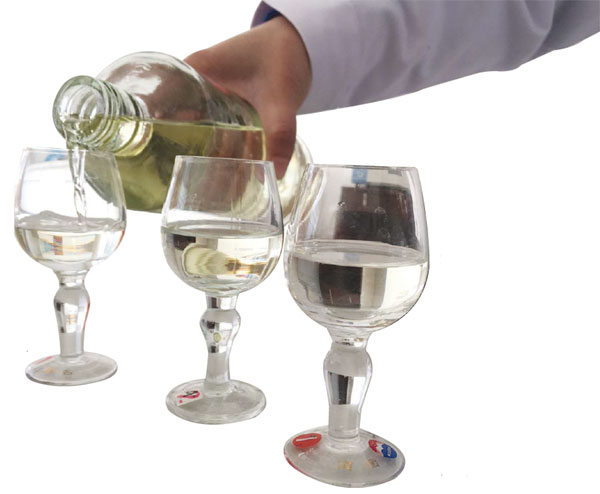
Blending master who gained a real taste for China's most-loved liquor, Moutai
Zhong Lin stopped wearing cosmetics and perfume in her 20s. She also swore off spicy food, which was tough for someone who grew up in Guizhou, a southern province where the chili is king.
Yet denying herself these everyday pleasures for two decades has helped make her one of the top baijiu blending masters in China.

|
Zhong Lin is one of the 10 blending masters who are responsible for the quality and consistency of the 100 metric tons of baijiu produced daily at Moutai's distilleries. Photos by Yan Dongjie / China Daily |
The job requires a heightened sense of taste and smell. "If you gave me two cups of baijiu with slightly varying alcohol levels, it'd be easy for me to tell which is higher, or any other tiny differences," she says with a confident smile.
Zhong has worked for Kweichow Moutai Co, the most famous brand of the Chinese liquor, since 1995, rising from a graduate recruit to a Class 1 taster.
She is one of 10 blending masters who are responsible for the quality and consistency of the 100 metric tons of baijiu produced daily at Moutai's distilleries, which employ more than 20,000 people in the Guizhou city from which the company takes its name.
"For the past 20 years, I've tasted the best baijiu in the world almost every day. It's been amazing," she says, adding that she believes it has done wonders for her liver and stomach, and that her skin is better than most women her age. "Moutai is great for your health," she says, repeating a statement often heard from workers at the company, although the public perception is perhaps a little different.
The company's baijiu is made from sorghum, wheat and water from the Red River, which runs through Moutai town, "with no chemicals or artificial yeasts", according to Zhong.
The wheat and sorghum are first mixed to ferment for a year before being categorized by taste and stored in large, earthenware containers for three to four years. After that, each batch is further tested to determine the right blend to produce the trademark Moutai flavor.
"The most difficult - albeit basic - part of my job is to make sure the baijiu produced in different seasons and different years all tastes roughly the same," she says.
Zhong is now at the peak age for tasters, 40 to 45, when the senses of smell and taste are believed to be at their keenest. However, acquiring the skills to be a blending master wasn't easy; it took years of practice.
At first, Zhong says she did not take her apprenticeship seriously enough and found it hard keeping up with the tiring training schedule, which often stretched into the late evening.
When her first chance to take the baijiu taster examination rolled around in 2000, she failed. "I was young and foolish, and I do regret it (not putting in the effort) because it delayed my career," she says, explaining that the test is only held every five years.
The failure inspired her to dedicate herself to improving her skills, which involved smelling and tasting glass upon glass of baijiu, each one slightly different from the one before. "You have to stop every now and then, take a walk to refresh the nose and drink some water to cleanse the palate."
Her hard work paid off. She rose through the ranks and eventually gained a Class 1 certificate, the highest achievement for a blending master, last year. For that test she was blindfolded and asked to tell the difference between various cups of water, including tap, mineral and purified.
"I smelled, but smelled nothing; I tasted, but didn't taste baijiu," she says, recalling her surprise at the exam. "But I passed, and at least I got to know that I'm capable of distinguishing between different types of water."
When asked to demonstrate her day-to-day work, Zhong put on a clean, white lab coat, washed her hands, and took out a collection of bottles and measuring glasses.
"Look at the color first," she says, explaining the process, which takes up to one hour per sample. "Smell it from a short distance, and then take a sip to spread the baijiu on your tongue."
Moutai was first produced during the Qing Dynasty (1644-1911). Since then, the traditional production methods employed at the company have remained relatively unchanged.
However, Zhong says output is kept limited to ensure the high quality of its baijiu, which was named the "national liquor" in 1951.
A standard 500-millimeter bottle of Moutai costs about 1,000 yuan ($154; 139 euros) from stores in the town, but that can rise up to 2,000 yuan in other cities because of supply and demand. Last year, an 80-year-old bottle of Moutai baijiu fetched a record 10.7 million yuan at auction.
"The only thing that's changed (in production) is that we've built blending vats with a capacity of 120 tons, replacing those used before 2008 that could hold only 5 tons," Zhong says. "We still rely on water from the Red River, so production of our baijiu can never leave Moutai town."
Although an established brand in China, the liquor manufacturer has been working to promote its products abroad, as well as explore online retail platforms.
As part of efforts to keep up with the times, Moutai assigned Zhong to head a team of five master's graduates in developing baijiu-based cocktails. The group is collaborating with Western mixologists and has organized several promotional events overseas, including in Italy, the United States and Russia.
"I'm encouraged to see Western people react positively to our new products, and some of them placed orders straight away," she says, adding that she hopes Moutai will be loved by more people around the world.
"There are no limits on the cocktail team. It's just given the space to make things happen."
Contact the writers through yandongjie@chinadaily.com.cn